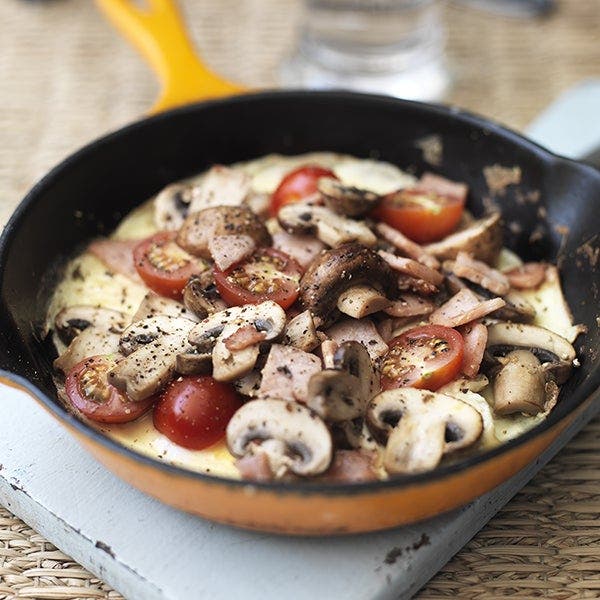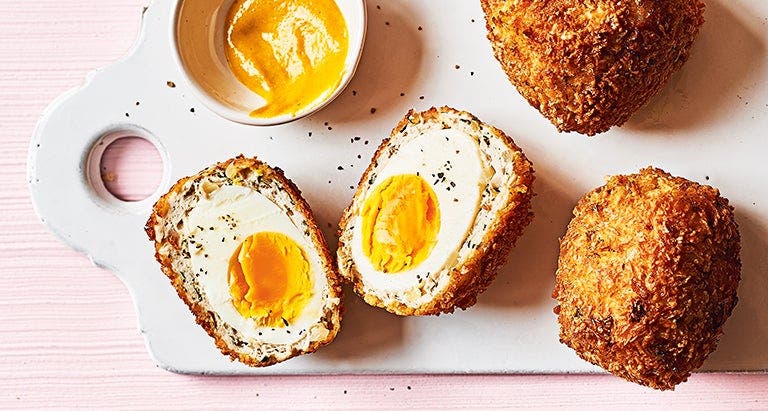Egg head: How to cook perfect eggs every time


Scrambled, fried, poached, hard-boiled, soft-boiled and even baked — there are so many ways to cook an egg. And yet, cooking them right remains a mystery to many of us.
But no more! We’ve got the basic tips so that hard-boiled eggs don’t have any more green rims around the yolk, scrambled eggs are light and fluffy, and baked eggs come out of the oven perfect every time. We’ve got the scoop on how to get the heat level right, the water temperature perfect and the stirring technique down, so that you end up with perfect eggs for breakfast, lunch and dinner.
Scrambled eggs
Low, slow and patient — these are the rules to remember for perfect scrambled eggs. By that we mean low heat, long cooking and constant stirring.
- Use a whisk to beat raw eggs - no milk or water necessary.
- Make sure eggs are well beaten in a bowl, even a little foamy, with no bits of white visible.
- Use a nonstick frying pan.
- Add calorie controlled cooking spray, or oil of your choice.
- Set frying pan over low heat to warm for 2 to 3 minutes.
- Pour in eggs — and begin stirring with a heat-safe silicone or rubber spatula. (A fork or a wooden spoon will not scrape egg off the hot surface as necessary).
- Keep stirring, scraping the bottom and sides of the pan for any thin bits as they form.
- It may take up to 5 minutes before any curds form. But don’t wait for curds to form to scrape and stir.
- Every time curds begin to form, scrape them up and fold them back into mix.
- Two to three beaten eggs should take up to 15 minutes over heat.
The result: a mound of very moist, light and airy scrambled eggs. Give the technique a go with our gourmet scrambled eggs with mushroom and smoked trout.
Omelette
Fast and fairly hot — the opposite technique for scrambled eggs — and the right combo for an impeccable omelette.
- Whisk in a bowl until foamy, with no bits of egg white visible.
- Use a nonstick frying pan and calorie controlled cooking spray, or oil of your choice.
- Set frying pan over medium-high heat for 1 minute.
- Pour in eggs all around the pan to make an even omelette.
- Eggs will instantly begin to set.
- You want as little browning as possible. A good omelette should take just a few minutes to set.
- When the bottom of the egg mixture has set, use a heat-safe silicone or rubber spatula to pull in sides of omelette from the edges of the pan.
- Tilt pan to allow raw egg to flow into gaps.
- Continue cooking, crimping once more, creating more gaps for raw egg to meet heat, and shaking pan repeatedly to make sure omelette has not stuck.
- Once top is set with no more loose egg, add any desired toppings - some of our faves include veggies, cheese and ham.
- Make sure omelette is loosened from hot surface. Take pan off heat and hold it over plate or serving platter. Let half of omelette slip out of pan over its lip and onto plate or platter, then use the pan to fold omelette onto itself by lifting pan's handle up and over plate.
Test out your skills with this yummy all day breakfast omelette.

Fried eggs
The trick here: medium, steady heat and a fair amount of shaking.
- Use a nonstick frying pan and add calorie controlled cooking spray or oil of your choice.
- Set frying pan over medium heat for 1 minute.
- Crack eggs one by one into a bowl, then gently pour each one into the pan by holding the bowl close to the hot surface.
- Never crack eggs directly into a frying pan. You can get bits of shell in the eggs or break the yolks.
- Only add as many eggs as the frying pan can hold without any of them touching.
- Once egg whites have turned opaque, shake the pan gently to loosen eggs from hot surface. You can also gently pry them loose with a heat-safe silicone or rubber spatula.
- Continue cooking, shaking occasionally, until whites have fully set, about 2 minutes.
- For sunny-side-up eggs, slip them out of pan now by holding pan over plate and letting them slide out over lip — or remove them with a nonstick-safe spatula.
- For over-easy eggs, flip them and cook for 10 seconds. Don’t remove with a spatula — it can break the yolk. Instead, tilt pan over plate and let them slide out one by one.
- For hard-cooked yolks, flip eggs and cook for up to 1 minute. Again, tilt pan over plate to slip eggs out — or use a heat-safe spatula.
Poached eggs
Skip the vinegar. You only need heat, water and patience.
- Bring a medium saucepan of water to a boil over high heat.
- Turn heat to lowest possible setting so you see no more bubbles in pan. You may need to wait a moment with an electric stove.
- Crack eggs one by one into a small bowl.
- Hold bowl right at water level and gently pour egg into saucepan.
- Cook no more than two eggs at a time — otherwise, the water temperature will drop too low. Pour each in a different section of pan.
- Cover pan and steep for 4 minutes.
- Lift out eggs one by one with a slotted spoon.
- Blot bottom of spoon with egg still in it on paper towels.
- Slip egg into a bowl to serve. Retrieve second egg, blot, and serve.
- Bring water back to a boil if you want to make more poached eggs — and start the process again.
Our herby vegetable hash with poached eggs makes a deliciously healthy lunch or light dinner. Why not give it a go one day this week?
Hard-boiled eggs
If you've ever wondered how to hard boil eggs, or how long to hard boil eggs, you're in the right place. And here’s the best news: no more green ring around the yolk!
- Use cold, in-the-shell eggs right out of the fridge.
- Put eggs in a large saucepan; fill pan with cool tap water so that eggs are covered with water by 1 inch.
- Bring to a full simmer over high heat — not yet a rolling boil.
- Start timing at full simmer (many large bubbles in pan). Cook for 1 minute. (The water will probably come to a rolling boil in that minute).
- Cover, remove pan from heat, and set aside for 4 minutes for a slightly gelatinous yolk, 5 minutes for a firmer set, or 6 minutes for a very hard set.
- Drain and cool eggs slightly with running tap water.
- Peel eggs while warm. (Cold hard-cooked eggs will not peel properly).
- Roll eggs one by one under your palm along a hard surface to crack shells a bit.
- If desired, peel under running water to help get some of the shell off.
Feeling like a hard boiled pro? Try our veggie scotch eggs or our egg and cress sandwich.

Soft-boiled eggs
- Use the same technique for hard-boiled eggs — setting them in cold water, bringing to a full simmer over high heat, cooking for 1 minute, removing them from heat — except now, let eggs sit in hot water off heat for only 30 seconds to 1 1/2 minutes, depending on desired set.
- Cool eggs only until you can handle them under running water, no more than a few seconds.
- Set them small-end up in egg cups; slice off top of shell (and white inside) with a sharp knife.
- Use a small spoon to scoop out egg inside shell — or scrape egg out of shell and into a serving bowl with a larger spoon.
Baked eggs
These are set in the oven in small, heat-safe ramekins.
- Heat oven to 180°C/350°F/gas mark 4
- Spray or grease as many small, oven-safe ramekins as desired.
- Use 1 egg per ramekin.
- Or use a muffin tin, spraying or greasing as many indentations as desired.
- Crack 1 large egg into each ramekin (or each muffin-tin indentation).
- Drizzle 2 teaspoons skimmed milk over top of each raw egg.
- Set ramekins in a roasting pan or on a baking sheet.
- Bake about 8 minutes for just-set yolks, 12 minutes for a firmer set.
- Cool 1 minute before digging in!
